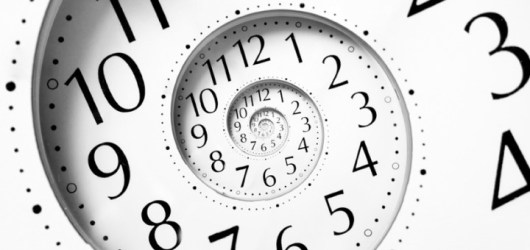
Reference: Disturbance Theory
.
Time is the property of endurance of a substance. In the absence of substance there is no endurance or time. The EMPTINESS (referenced earlier) is devoid of substance, and, therefore, it is also devoid of time.
Time is essentially the manifestation of change, which could be ephemeral or enduring. It could be a change in physical extensions perceived objectively; or it could be a change in mental abstractions experienced subjectively. The former is represented by the clock time; and the latter is simply felt inwardly.
We limit our considerations of time to changes in physical extensions perceived objectively.
We now consider physical substance broadly to be field, with matter as a special instance. The field is made up of cycles. The changes in frequencies of these cycles provide varying endurance or time. The duration of a single cycle is called a PERIOD.
The duration of field is made up of period of its cycles.
The period and wavelength of a cycle are closely related. If cycle is represented by a turn of a screw then period is the duration of that turn and wavelength is the advance made by the screw during that turn. The wavelength and period are proportional to each other.
The period is proportional to the wavelength of the cycle.
The ratio of wavelength to period is now considered a universal constant. This constant is ‘c’, known popularly as the speed of light. Like the Planck’s constant ‘h’, the ratio ‘c’ also remains constant for a cycle regardless of its frequency. Therefore, as frequency increase and cycles become denser, and both wavelength and period shrink as one.
As the period shrinks with increasing frequency the endurance of cycles increases.
Like the wavelength, period is also infinitesimal for matter and appears to be unchanging and absolute. It determines the character of time as absolute in relation to material objects. This is the clock time of Newton.
The infinitely enduring characteristic of matter represents the absolute time of Newton.
Space and time appear to be absolute and independent at the level of matter because their characteristics do not appear to vary. They do not appear to be related to each other by the universal constant ‘c’. We associate ‘c’ with the speed of light, which is unaffected by the usual speed of matter.
Newtonian mechanics works perfectly well at the level of matter, where cycles of field are infinitesimal in wavelength and period.
But when we consider “speeds closer to the speed of light”, we are actually considering phenomena that are closer to much smaller frequency and inertia of light. In this domain the cycles of field are finite in wavelength and period. They can be seen as dependent on each other by the proportionality constant ‘c’.
Relativistic mechanics comes into play for the field where cycles are not dense enough to have infinitesimal wavelength and period.
Relativistic addition replaces the vector addition of Newtonian mechanics where quantities being added are far apart in their velocity or frequency by many orders of magnitude. Einstein’s mathematical derivation of time dilation can now be understood better in terms of varying period of the field.
Einstein’s “time dilation” relates to the period of cycle increasing.
The cycles repeat in continuous sequence. This sequence is also a characteristic of time. The continuity of sequence is maintained despite changes in frequency. The frequency changes show up as gradients in the field. The gradient of frequency may reverse but time is not seen as reversing because, relative to perception, the change is always occurring in a “forward” sequence.
We perceive the flow of time in the “forward” sequence only.
It must be emphasized that space and time exist as properties of field and matter. They do not exist in the absence of field and matter.
Matter does not “move in space”; instead, it moves in the field and inertia represents the resistance to this motion.
Field is not a “condition in space”; instead it determies the varying conditions of space and time.
.
